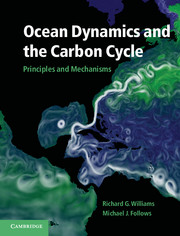Book contents
- Frontmatter
- Contents
- Preface
- Acknowledgements
- Illustration credits
- Part I Introduction
- Part II Fundamentals
- Part III Physical Phenomena and their Biogeochemical Signals
- 7 Seasonality of the upper ocean
- 8 Ocean gyres and intense currents
- 9 Ocean eddies
- 10 Ventilation
- 11 Cycling and transport of nutrients and carbon
- 12 The deep ocean and overturning
- Part IV Synthesis
- Appendix
- Symbols and definitions
- Glossary
- Answers
- References
- Index
- Plate section
9 - Ocean eddies
from Part III - Physical Phenomena and their Biogeochemical Signals
Published online by Cambridge University Press: 05 June 2012
- Frontmatter
- Contents
- Preface
- Acknowledgements
- Illustration credits
- Part I Introduction
- Part II Fundamentals
- Part III Physical Phenomena and their Biogeochemical Signals
- 7 Seasonality of the upper ocean
- 8 Ocean gyres and intense currents
- 9 Ocean eddies
- 10 Ventilation
- 11 Cycling and transport of nutrients and carbon
- 12 The deep ocean and overturning
- Part IV Synthesis
- Appendix
- Symbols and definitions
- Glossary
- Answers
- References
- Index
- Plate section
Summary
The ocean and atmosphere are full of swirling circulations, flows changing their velocity in time and/or space, which are generically referred to as eddies. Eddies are seen whenever we look at moving fluids, like small-scale vortices formed by a paddle moving in the water, in the turbulent wake of a river flowing around a rock, and on a grander scale like the weather systems where hook-like ice clouds warn of an oncoming warm front. An eddy might sometimes represent a reversing oscillation, such as in how a stick is swept back and forth as a gentle wave passes by, or an irreversible transfer, as in how surf is swept in a breaking wave towards the shore.
Eddy variability is particularly pronounced on horizontal scales of several tens to a hundred kilometres in the ocean, referred to as the mesoscale, and on scales of a thousand kilometres in the atmosphere, referred to as the synoptic scale and linked to weather systems. Both these ocean eddies and atmospheric weather systems are generated through the instability of intense jets and narrow currents. For example, meanders in the Gulf Stream can intensify and break off from the current, forming mesoscale eddies, which have warm cores to the north or cold cores to the south of the current, respectively, as depicted in Figs. 9.1 and 9.2. Weather systems are likewise formed by meanders developing along the atmospheric Jet Stream, eventually leading to warm air swept poleward ahead of a low pressure and cold air swept equatorward behind the low.
- Type
- Chapter
- Information
- Ocean Dynamics and the Carbon CyclePrinciples and Mechanisms, pp. 211 - 235Publisher: Cambridge University PressPrint publication year: 2011
- 1
- Cited by



